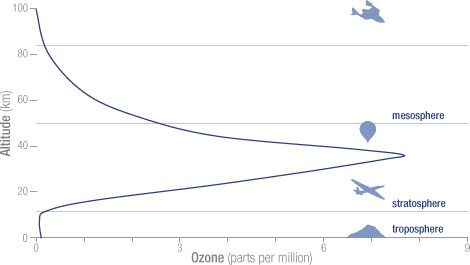On October 24, 2012 NASA and NOAA released satellite data showing that this year’s Antarctic ozone hole was the second smallest recorded over the past 20 years. Scientists attribute the small size of the ozone hole this year to warm atmospheric temperatures. Full recovery of the Antarctic ozone layer due to the phase out of ozone-depleting substances is not expected to happen until the latter half of the 21st century.
Ozone is a gas composed of three oxygen atoms (O3). It is a naturally occurring substance in the upper portions of the atmosphere called the stratosphere. Stratospheric ozone absorbs incoming ultraviolet radiation from the Sun. Hence, the ozone layer plays an important role in shielding life on Earth from the damaging effects of ultraviolet radiation.

Ozone levels over Antarctica dropped steeply during the 1980s due to the use of ozone-depleting substances such as chlorofluorocarbons (CFCs) in refrigerators, air conditioners, aerosol cans and cleaning agents. These chemicals are long-lived and are transported into the stratosphere where they react with and destroy ozone molecules. In 1987, an international treaty known as the Montreal Protocol was signed to phase out the use of ozone-depleting substances.
NASA (National Aeronautics and Space Administration) and NOAA (National Oceanic and Atmospheric Administration) have been monitoring the size of the ozone hole over Antarctica since 1979. An ozone hole forms near the south pole each year during the austral spring and reaches its maximum extent in late September or early October. The ozone hole grows to its largest size in the spring due to a combination of cold temperatures, the presence of stratospheric clouds, wind circulation patterns and the gradual appearance of sunlight after the long, dark winter. These conditions act to accelerate the destruction of ozone by man-made chemicals.
Since the 1990s, the size of the Antarctic ozone hole has remained relatively stable at an average of about 22.3 million square kilometers (8.6 million square miles). The largest ozone hole – based on satellite measurements averaged over the days of September 7 to October 13 – was recorded in 2006 and measured 26.6 million square kilometers (10.3 million square miles).
This year the Antarctic ozone hole reached its maximum extent on September 22, 2012. The averaged size of the ozone hole in 2012 was 17.9 million square kilometers (6.9 million square miles). It was the second smallest size recorded in the past 20 years.

Scientists attribute the small size of the ozone hole this year to warm atmospheric temperatures.
Paul Newman, an atmospheric scientist from NASA’s Goddard Space Flight Center in Maryland, commented on the findings. He said:
The ozone hole mainly is caused by chlorine from human-produced chemicals, and these chlorine levels are still sizable in the Antarctic stratosphere. Natural fluctuations in weather patterns resulted in warmer stratospheric temperatures this year. These temperatures led to a smaller ozone hole.
Full recovery of the Antarctic ozone layer due to the phase out of ozone-depleting substances is not expected to happen until the latter half of the 21st century.
The ozone hole was measured this year with new instrumentation aboard the Suomi National Polar-orbiting Partnership (NPP) satellite. Scientists hope that the new technology will help them to better understand vertical changes as well as horizontal changes in stratospheric ozone concentrations.
Bottom line: On October 24, 2012 NASA and NOAA released satellite data showing that this year’s Antarctic ozone hole was the second smallest recorded over the past 20 years. Scientists attribute the small size of the ozone hole this year to warm atmospheric temperatures. Full recovery of the Antarctic ozone layer due to the phase out of ozone-depleting substances is not expected to happen until the latter half of the 21st century.
Is there good ozone and bad ozone?
First-ever Arctic ozone hole: How it formed, what it may mean











